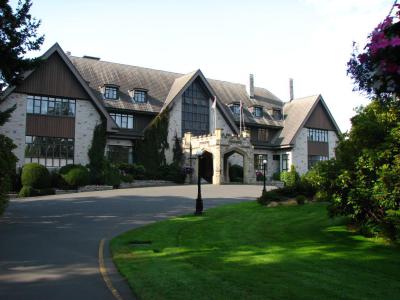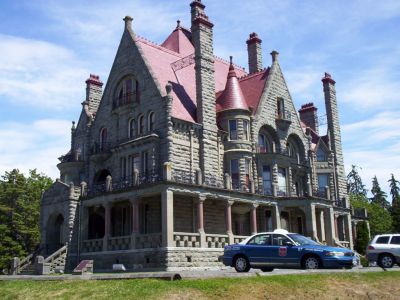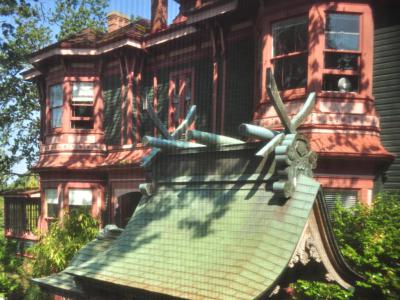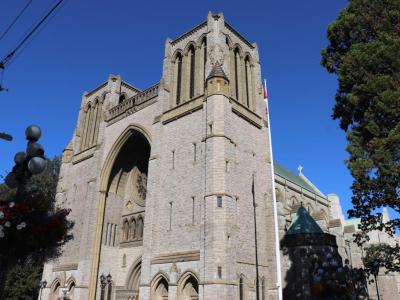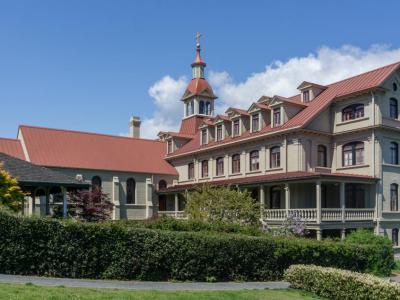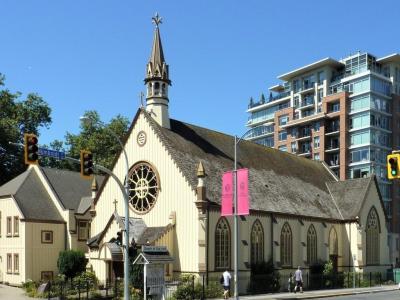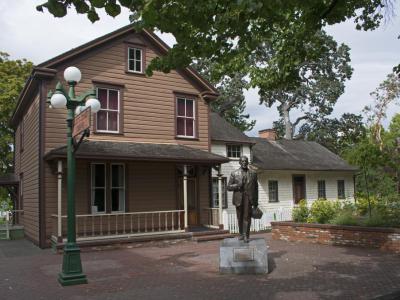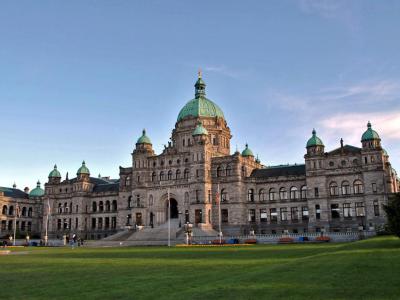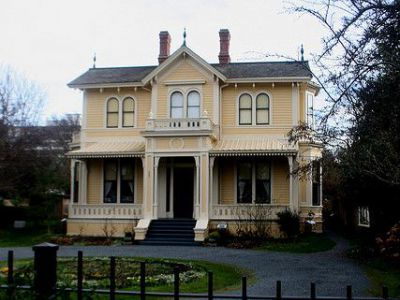
Victoria's Historical Buildings Walking Tour (Self Guided), Victoria
They say, Victoria is a jewel of a city with its blend of timeless charm and grace, in which historic architecture coexists with a modern and vibrant cultural scene. Indeed, for a relatively young city, Victoria boasts a wealth of incredibly beautiful heritage sites carefully preserved for future generations to enjoy. The moment you cruise into the capital of British Columbia, you can feel a strong historical presence manifested in period buildings reflecting the city's growth and change over the years.
History truly resonates here through architecture. Everything, from the imposing, dome-topped Parliament Buildings to the Government House (an official residence of the Lieutenant Governor of British Columbia) to the nearby Craigdarroch Castle (a striking example of the Victorian style), seems to be transporting you back to a bygone era.
In addition to these landmarks, the city has many other architectural gems such as the Art Gallery of Greater Victoria, featuring a lovely mix of Tudor Revival and Arts & Crafts styles, a Gothic-Revival Christ Church Cathedral, and the historic Helmcken House, to mention but a few.
Apart from being old, these are truly exceptional pieces of architectural design and craftsmanship that are a living, breathing part of the city's history that can be experienced and appreciated in the present day. Exploring Victoria's historic buildings is like taking a leisurely stroll through time. On this self-guided walk, you can hear their unique stories set in stone and get a glimpse into the city's past.
History truly resonates here through architecture. Everything, from the imposing, dome-topped Parliament Buildings to the Government House (an official residence of the Lieutenant Governor of British Columbia) to the nearby Craigdarroch Castle (a striking example of the Victorian style), seems to be transporting you back to a bygone era.
In addition to these landmarks, the city has many other architectural gems such as the Art Gallery of Greater Victoria, featuring a lovely mix of Tudor Revival and Arts & Crafts styles, a Gothic-Revival Christ Church Cathedral, and the historic Helmcken House, to mention but a few.
Apart from being old, these are truly exceptional pieces of architectural design and craftsmanship that are a living, breathing part of the city's history that can be experienced and appreciated in the present day. Exploring Victoria's historic buildings is like taking a leisurely stroll through time. On this self-guided walk, you can hear their unique stories set in stone and get a glimpse into the city's past.
How it works: Download the app "GPSmyCity: Walks in 1K+ Cities" from Apple App Store or Google Play Store to your mobile phone or tablet. The app turns your mobile device into a personal tour guide and its built-in GPS navigation functions guide you from one tour stop to next. The app works offline, so no data plan is needed when traveling abroad.
Victoria's Historical Buildings Walking Tour Map
Guide Name: Victoria's Historical Buildings Walking Tour
Guide Location: Canada » Victoria (See other walking tours in Victoria)
Guide Type: Self-guided Walking Tour (Sightseeing)
# of Attractions: 9
Tour Duration: 2 Hour(s)
Travel Distance: 4.0 Km or 2.5 Miles
Author: alice
Sight(s) Featured in This Guide:
Guide Location: Canada » Victoria (See other walking tours in Victoria)
Guide Type: Self-guided Walking Tour (Sightseeing)
# of Attractions: 9
Tour Duration: 2 Hour(s)
Travel Distance: 4.0 Km or 2.5 Miles
Author: alice
Sight(s) Featured in This Guide:
- Government House
- Craigdarroch Castle
- Art Gallery of Greater Victoria (AGGV)
- Christ Church Cathedral
- St. Ann's Academy
- Church of Our Lord
- Helmcken House
- British Columbia Parliament Buildings
- Emily Carr House
1) Government House
An iconic landmark that has been an important part of the Victoria's history since it was first built in 1858, the Government House is the official residence of the Lieutenant Governor of British Columbia, Canada.
Visitors can explore the beautifully landscaped gardens that surround the property, which feature a wide variety of plants and trees from around the world. There are also numerous walking paths and trails that offer stunning views of the gardens and the city.
One of the main attractions here is the ceremonial Changing of the Guard, which takes place every summer. Visitors can watch as the guards, dressed in their traditional red and black uniforms, march through the grounds accompanied by a military band.
Inside the house, visitors can take a guided tour to learn about the history of the building and its significance to the province. The tour includes the main reception rooms, the ballroom, and the private quarters of the Lieutenant Governor.
Another popular attraction is the Tea Room, which serves traditional high tea and other refreshments. Visitors can relax and enjoy the elegant surroundings while sipping on tea and nibbling on sandwiches and pastries.
In addition to these activities, Government House also hosts a variety of events throughout the year, including concerts, garden parties, and cultural celebrations.
Why You Should Visit:
With its rich history, beautiful gardens, and unique cultural experiences, the Government House offers something for everyone to enjoy.
Beautiful place to stop on a walk through the lovely and historic neighborhood of Rockland.
On a clear day, from numerous vantage points, you can see the Olympic Mountains.
Visitors can explore the beautifully landscaped gardens that surround the property, which feature a wide variety of plants and trees from around the world. There are also numerous walking paths and trails that offer stunning views of the gardens and the city.
One of the main attractions here is the ceremonial Changing of the Guard, which takes place every summer. Visitors can watch as the guards, dressed in their traditional red and black uniforms, march through the grounds accompanied by a military band.
Inside the house, visitors can take a guided tour to learn about the history of the building and its significance to the province. The tour includes the main reception rooms, the ballroom, and the private quarters of the Lieutenant Governor.
Another popular attraction is the Tea Room, which serves traditional high tea and other refreshments. Visitors can relax and enjoy the elegant surroundings while sipping on tea and nibbling on sandwiches and pastries.
In addition to these activities, Government House also hosts a variety of events throughout the year, including concerts, garden parties, and cultural celebrations.
Why You Should Visit:
With its rich history, beautiful gardens, and unique cultural experiences, the Government House offers something for everyone to enjoy.
Beautiful place to stop on a walk through the lovely and historic neighborhood of Rockland.
On a clear day, from numerous vantage points, you can see the Olympic Mountains.
2) Craigdarroch Castle (must see)
Built between 1887 and 1890 by wealthy coal baron Robert Dunsmuir, Craigdarroch Castle is an impressive Scottish Baronial mansion that is now open to the public as a museum.
The castle's architecture is a prime example of the Victorian architectural style, characterized by its ornate details, intricate woodwork, and elaborate stonework. The exterior is made of local granite, while the interior features a mix of exotic woods, stained glass windows, and intricate plasterwork.
Visitors to Craigdarroch Castle can take a self-guided tour of the mansion's four floors, which are filled with period furniture, artwork, and other artifacts. Some of the tour's highlights include the grand staircase, the drawing room, the billiard room, and the bedrooms, which are decorated in a variety of styles ranging from Gothic Revival to Rococo.
In addition to the castle itself, the property also features stunning gardens that are open to the public, meticulously maintained and including a mix of exotic and native plants, as well as several fountains and statues.
Throughout the year, Craigdarroch Castle hosts a variety of events and activities, including holiday-themed tours, concerts, and educational programs for children. There is also a gift shop on site, where visitors can purchase souvenirs and other items related to the castle and its history.
Why You Should Visit:
Very unique place for western Canada. Apart from the self-guided tour, the young volunteers stationed around the various rooms are very helpful. If you enjoy anything exquisitely Victorian-era or are a fan of wooden craftsmanship, then this is a must.
Tip:
To fully appreciate the castle, you will need to be fit enough to walk up the staircases (no elevator) to the different sections from the restored bedrooms to the upstairs ballroom. Make sure to also walk up the top turret and admire the views!
The castle's architecture is a prime example of the Victorian architectural style, characterized by its ornate details, intricate woodwork, and elaborate stonework. The exterior is made of local granite, while the interior features a mix of exotic woods, stained glass windows, and intricate plasterwork.
Visitors to Craigdarroch Castle can take a self-guided tour of the mansion's four floors, which are filled with period furniture, artwork, and other artifacts. Some of the tour's highlights include the grand staircase, the drawing room, the billiard room, and the bedrooms, which are decorated in a variety of styles ranging from Gothic Revival to Rococo.
In addition to the castle itself, the property also features stunning gardens that are open to the public, meticulously maintained and including a mix of exotic and native plants, as well as several fountains and statues.
Throughout the year, Craigdarroch Castle hosts a variety of events and activities, including holiday-themed tours, concerts, and educational programs for children. There is also a gift shop on site, where visitors can purchase souvenirs and other items related to the castle and its history.
Why You Should Visit:
Very unique place for western Canada. Apart from the self-guided tour, the young volunteers stationed around the various rooms are very helpful. If you enjoy anything exquisitely Victorian-era or are a fan of wooden craftsmanship, then this is a must.
Tip:
To fully appreciate the castle, you will need to be fit enough to walk up the staircases (no elevator) to the different sections from the restored bedrooms to the upstairs ballroom. Make sure to also walk up the top turret and admire the views!
3) Art Gallery of Greater Victoria (AGGV)
The Art Gallery of Greater Victoria comprises two distinct parts: the Spencer Mansion and the Exhibition Galleries. The former, a Victorian-style residence built in 1889 by William Ridgeway Wilson, was repurposed to house the museum. It was once part of a larger property that included a garden, two tennis courts, stables, and a coach house, and even had a belvedere with a view of the ocean. Originally called Gyppeswyk (which means Ipswich in Old English), the mansion was built for the Green family. After the destruction of the original Government House, Cary Castle, in 1903, Gyppeswyk briefly served as the residence of the Lieutenant Governor of British Columbia. In 1951, Sarah Spencer donated the building to the institution that later became the Art Gallery of Greater Victoria (AGGV).
The Exhibition Galleries, on the other hand, are a modernist-style expansion wing consisting of seven galleries. They were built in phases between the 1950s and 1978 and provide a striking contrast between historic and modern architecture, which is characteristic of the gallery's overall aesthetic.
The AGGV's largest and most prominent gallery is the Main Gallery, which showcases the museum's permanent collection of over 20,000 works of art from different time periods and cultures, including contemporary Canadian and international, historical European, and Asian art. Meanwhile, the Contemporary Gallery is dedicated to showcasing works that challenge traditional artistic conventions and push the boundaries of what is possible in art.
Moreover, the museum houses the Ker Gallery, which focuses on Inuit and First Nations art; the Lab Gallery, which showcases experimental and multimedia works; and the Founders' Gallery, which features historical Canadian art from the early 20th century.
In addition to its permanent collection, the AGGV also hosts a range of temporary exhibitions throughout the year. These exhibitions often feature works by both established and emerging artists and cover a wide range of artistic styles and themes.
Why You Should Visit:
A testament to the city's rich history and culture, the Spencer Masion provides a fitting backdrop for the museum's impressive collection of art.
Friendly staff, tranquil atmosphere, the gift shop is definitely worth a look and there is also art available for sale or rent.
Tip:
Watch the AGGV website for openings, exhibits, special events, and sales.
The Exhibition Galleries, on the other hand, are a modernist-style expansion wing consisting of seven galleries. They were built in phases between the 1950s and 1978 and provide a striking contrast between historic and modern architecture, which is characteristic of the gallery's overall aesthetic.
The AGGV's largest and most prominent gallery is the Main Gallery, which showcases the museum's permanent collection of over 20,000 works of art from different time periods and cultures, including contemporary Canadian and international, historical European, and Asian art. Meanwhile, the Contemporary Gallery is dedicated to showcasing works that challenge traditional artistic conventions and push the boundaries of what is possible in art.
Moreover, the museum houses the Ker Gallery, which focuses on Inuit and First Nations art; the Lab Gallery, which showcases experimental and multimedia works; and the Founders' Gallery, which features historical Canadian art from the early 20th century.
In addition to its permanent collection, the AGGV also hosts a range of temporary exhibitions throughout the year. These exhibitions often feature works by both established and emerging artists and cover a wide range of artistic styles and themes.
Why You Should Visit:
A testament to the city's rich history and culture, the Spencer Masion provides a fitting backdrop for the museum's impressive collection of art.
Friendly staff, tranquil atmosphere, the gift shop is definitely worth a look and there is also art available for sale or rent.
Tip:
Watch the AGGV website for openings, exhibits, special events, and sales.
4) Christ Church Cathedral
Like so many of the majestic cathedrals of old, Christ Church Cathedral took over a century to construct and has evolved dramatically from its original conception. This edifice is none other than the third Cathedral Church, proudly standing as the seat of the Bishop of the Anglican Diocese of British Columbia. It replaced two previous structures that once graced the opposite side of the road, now home to the Law Courts building. The old cathedral property may have been sold to the province for the courthouse, but the Cathedral Close still occupies an entire city block, encompassing Quadra, Rockland, Vancouver, and Burdett.
The architect Keith himself called the cathedral Gothic Revival, acknowledging the immense influence of medieval English cathedrals. The design is steeped in tradition, with the visual emphasis placed on the grand West End, which majestically towers over "Church Hill," boasting its prominence for miles around.
A grand entrance awaits worshippers, beckoning them to enter through six sets of double doors, which lead through a vestibule, also known as the narthex, into the vast and sprawling nave. At the east end, facing Jerusalem, lies the resplendent sanctuary. The finished nave is one of the largest in all of Canada, spanning a breathtaking 93 feet by 140 feet. Medieval-style texts grace the interior walls, transporting visitors to a time long gone, while other texts are artfully cast in a ribbon around the top of the walls outside, paying homage to the grandeur of this magnificent cathedral.
Why You Should Visit:
For Gothic architecture, this is really a beautiful structure – with flying buttresses, beautiful beams, and gorgeous stained glass – surrounded by impeccably manicured grounds and the peaceful cemetery.
A delightful labyrinth graces the side of the building, inviting visitors to embark on a spiritual journey of self-discovery.
Tip:
Upon arrival, kindly ask the knowledgeable stewart on duty for the complimentary self-guided tour pamphlet to fully appreciate the building's historical and architectural significance. If you are especially gracious and polite, the stewart may even unlock the door to the Columbarium. The Cathedral is also known as a frequent venue for concerts and recitals, so check their schedule.
The architect Keith himself called the cathedral Gothic Revival, acknowledging the immense influence of medieval English cathedrals. The design is steeped in tradition, with the visual emphasis placed on the grand West End, which majestically towers over "Church Hill," boasting its prominence for miles around.
A grand entrance awaits worshippers, beckoning them to enter through six sets of double doors, which lead through a vestibule, also known as the narthex, into the vast and sprawling nave. At the east end, facing Jerusalem, lies the resplendent sanctuary. The finished nave is one of the largest in all of Canada, spanning a breathtaking 93 feet by 140 feet. Medieval-style texts grace the interior walls, transporting visitors to a time long gone, while other texts are artfully cast in a ribbon around the top of the walls outside, paying homage to the grandeur of this magnificent cathedral.
Why You Should Visit:
For Gothic architecture, this is really a beautiful structure – with flying buttresses, beautiful beams, and gorgeous stained glass – surrounded by impeccably manicured grounds and the peaceful cemetery.
A delightful labyrinth graces the side of the building, inviting visitors to embark on a spiritual journey of self-discovery.
Tip:
Upon arrival, kindly ask the knowledgeable stewart on duty for the complimentary self-guided tour pamphlet to fully appreciate the building's historical and architectural significance. If you are especially gracious and polite, the stewart may even unlock the door to the Columbarium. The Cathedral is also known as a frequent venue for concerts and recitals, so check their schedule.
5) St. Ann's Academy
As you enter Saint Ann's Academy, you'll be greeted by a grand wrought-iron gate and an elegant drive that leads you to the formal entrance of the former school. Step inside and you'll find yourself transported to the 1920s, with the parlours and chapel boasting stunning ornate details, reminiscent of rural French Canadian churches.
The chapel, once Victoria's first Roman Catholic Cathedral, was originally built in 1858 and later moved and added to the school in 1886. It features intricate carvings on the altar and ceiling, gold-leaf detailing, original oil paintings, beautiful stained glass windows, and the 1913 Casavant pipe organ, which fills the space with majestic music.
As you stroll through the Novitiate garden at the side entrance of the chapel, you'll find a geometric herb bed, perennials, and a delightful recreated 1925 summerhouse. The formal garden at the north-west corner of the property, built in 1910, is equally impressive, with rare trees and the remains of a unique fountain.
A portion of the building, known as the Interpretive Centre, has been restored to its original 1920s appearance, while the rest has been converted into modern office space leased by the Ministry of Advanced Education. The Ministry of Technology, Innovation and Citizens' Services operates the Interpretive Center, which celebrates the rich history of this important landmark. Additionally, the beautifully restored 1910 auditorium and 6 acres of grounds are available for public use. So come and experience the grandeur and history of Saint Ann's Academy for yourself.
The chapel, once Victoria's first Roman Catholic Cathedral, was originally built in 1858 and later moved and added to the school in 1886. It features intricate carvings on the altar and ceiling, gold-leaf detailing, original oil paintings, beautiful stained glass windows, and the 1913 Casavant pipe organ, which fills the space with majestic music.
As you stroll through the Novitiate garden at the side entrance of the chapel, you'll find a geometric herb bed, perennials, and a delightful recreated 1925 summerhouse. The formal garden at the north-west corner of the property, built in 1910, is equally impressive, with rare trees and the remains of a unique fountain.
A portion of the building, known as the Interpretive Centre, has been restored to its original 1920s appearance, while the rest has been converted into modern office space leased by the Ministry of Advanced Education. The Ministry of Technology, Innovation and Citizens' Services operates the Interpretive Center, which celebrates the rich history of this important landmark. Additionally, the beautifully restored 1910 auditorium and 6 acres of grounds are available for public use. So come and experience the grandeur and history of Saint Ann's Academy for yourself.
6) Church of Our Lord
As a national historic site, the Church of Our Lord and its annex stand as an important landmark in the heart of Victoria. Erected in 1875 by the Reverend Edward Cridge, this structure stands as a remarkable example of Gothic Revival architecture.
The renowned architect, John Teague, meticulously enhanced the building's Gothic character using board-and-batten siding to accentuate the verticality of its pointed roof, pinnacles, and spire. The church's exterior showcases traditional Gothic design elements of brick and stone, all expertly adapted to wood construction, giving rise to a unique, picturesque building.
The magnificent interior boasts a Gothic hammer beam ceiling, which spans the vast open space to provide an uninterrupted view of the apse and pulpit. Visitors can appreciate the expert craftsmanship of the woodwork and design, while also admiring the stained-glass windows and grand organ inside.
The renowned architect, John Teague, meticulously enhanced the building's Gothic character using board-and-batten siding to accentuate the verticality of its pointed roof, pinnacles, and spire. The church's exterior showcases traditional Gothic design elements of brick and stone, all expertly adapted to wood construction, giving rise to a unique, picturesque building.
The magnificent interior boasts a Gothic hammer beam ceiling, which spans the vast open space to provide an uninterrupted view of the apse and pulpit. Visitors can appreciate the expert craftsmanship of the woodwork and design, while also admiring the stained-glass windows and grand organ inside.
7) Helmcken House
Helmcken House was built in 1852 for Dr. John Sebastian Helmcken, a prominent physician, and politician who played a crucial role in the early history of British Columbia. Considered one of the oldest remaining houses in British Columbia, it is now a popular tourist attraction.
The building's architecture reflects the colonial style of the mid-19th century. It is a simple, rectangular wooden structure, with a steep gabled roof and a central chimney. The walls are made of hand-hewn, square-cut timbers that were covered with split cedar shakes. Inside, the house is divided into several rooms, with a central hallway and a staircase leading to the upper level. Interior furnishings are mainly original or replicas from the mid-19th century.
The history of Helmcken House is closely linked to the history of British Columbia. Dr. Helmcken played a significant role in the establishment of the colony and the creation of the province. He was also one of the signatories of the BC Terms of Union, which united British Columbia with the rest of Canada in 1871.
Helmcken House remained in the Helmcken family until 1930, when it was purchased by the Province. The house was restored to its original condition in the 1940s and became a historic site open to the public in 1955.
Why You Should Visit:
Quick glimpse into the past that provides some additional insight and history in a different context than that of the Royal Museum.
The building's architecture reflects the colonial style of the mid-19th century. It is a simple, rectangular wooden structure, with a steep gabled roof and a central chimney. The walls are made of hand-hewn, square-cut timbers that were covered with split cedar shakes. Inside, the house is divided into several rooms, with a central hallway and a staircase leading to the upper level. Interior furnishings are mainly original or replicas from the mid-19th century.
The history of Helmcken House is closely linked to the history of British Columbia. Dr. Helmcken played a significant role in the establishment of the colony and the creation of the province. He was also one of the signatories of the BC Terms of Union, which united British Columbia with the rest of Canada in 1871.
Helmcken House remained in the Helmcken family until 1930, when it was purchased by the Province. The house was restored to its original condition in the 1940s and became a historic site open to the public in 1955.
Why You Should Visit:
Quick glimpse into the past that provides some additional insight and history in a different context than that of the Royal Museum.
8) British Columbia Parliament Buildings (must see)
The British Columbia Parliament Buildings are a group of imposing structures situated in Victoria, which were completed in 1898 and are considered a perfect example of the Neo-baroque Renaissance style of architecture. Their stunning design incorporates a range of features like columns, pediments, domes, and classical motifs. The central building is the most notable of the complex, with a magnificent central dome reaching a height of 75 meters, making it the fourth-tallest dome in the world. Atop it is a gold-covered statue of Captain George Vancouver.
The Neo-baroque complex consists of three main buildings, namely the central legislative building, the west wing, and the east wing. The central building houses the Legislative Assembly, which is the lawmaking body of the province. The legislative chambers located in the central building are open to the public when the legislature is not in session.
The west wing of the buildings houses the offices of Members of the Legislative Assembly (MLAs) and the Legislative Library. The east wing is home to government administrative offices, including the offices of the Premier and the Lieutenant Governor.
These buildings are rich in history, having witnessed many significant events since their opening in 1898 - including the introduction of women's suffrage, the establishment of the provincial flag and coat of arms, and the first meeting of the Western Premiers Conference.
Today, they are a popular tourist destination and are open for public tours. Visitors can explore the stunning architecture, learn about the history of the buildings and the province, and witness the daily workings of the Legislative Assembly. The interiors are also home to numerous works of art, including paintings, sculptures, and murals, which further enhance the beauty of this historic site.
Why You Should Visit:
The buildings and the surrounding garden knoll are spectacular, both at night and during the day.
Mesmerizing interior with mosaic tiles, painted ceilings, and stellar stain glass windows.
You'll be able to take a self-walking tour or a guided tour of portions of Parliament.
Tip:
Make sure you do the indoor tour, as well as the garden tour – both are free!
You can also sign in at the security desk and visit the basement restaurant which is frequented by all the politicians.
The Neo-baroque complex consists of three main buildings, namely the central legislative building, the west wing, and the east wing. The central building houses the Legislative Assembly, which is the lawmaking body of the province. The legislative chambers located in the central building are open to the public when the legislature is not in session.
The west wing of the buildings houses the offices of Members of the Legislative Assembly (MLAs) and the Legislative Library. The east wing is home to government administrative offices, including the offices of the Premier and the Lieutenant Governor.
These buildings are rich in history, having witnessed many significant events since their opening in 1898 - including the introduction of women's suffrage, the establishment of the provincial flag and coat of arms, and the first meeting of the Western Premiers Conference.
Today, they are a popular tourist destination and are open for public tours. Visitors can explore the stunning architecture, learn about the history of the buildings and the province, and witness the daily workings of the Legislative Assembly. The interiors are also home to numerous works of art, including paintings, sculptures, and murals, which further enhance the beauty of this historic site.
Why You Should Visit:
The buildings and the surrounding garden knoll are spectacular, both at night and during the day.
Mesmerizing interior with mosaic tiles, painted ceilings, and stellar stain glass windows.
You'll be able to take a self-walking tour or a guided tour of portions of Parliament.
Tip:
Make sure you do the indoor tour, as well as the garden tour – both are free!
You can also sign in at the security desk and visit the basement restaurant which is frequented by all the politicians.
9) Emily Carr House
A National Historic Site located in the James Bay neighborhood of Victoria, this house was built in 1863 and was originally owned by the O'Reilly family, but it is best known as the childhood home of the renowned Canadian artist and writer, Emily Carr (b. 1871), who lived in there with her family until 1886. Emily Carr's sisters later donated the house to the Province of British Columbia as a memorial to their sister's life and work.
The house has been restored to its original state and features exhibits that showcase the life and work of Emily Carr. Visitors can take guided tours to learn about the artist's upbringing, her relationship with her family, and her development as an artist and writer.
Emily Carr is considered one of Canada's most important artists and writers. Her work, which was inspired by the landscape and Indigenous cultures of British Columbia, is renowned for its bold and expressive style. Carr's writing, including her autobiography "Growing Pains," is also highly regarded for its insightful reflections on her life and the world around her.
In all, a popular destination for art lovers, history enthusiasts, and anyone interested in learning more about one of Canada's most important cultural figures.
Why You Should Visit:
Charming and very nostalgic place that definitely gives you a glimpse into history.
There are many of Carr's writings on display, together with some reproductions of her art.
The gardens are beautifully maintained and there's a small gift shop where good books about her life and her art are available.
Tip:
Along the way, you may see many fine examples of older Victorian and craftsman style homes, many of them with very nice gardens.
The house has been restored to its original state and features exhibits that showcase the life and work of Emily Carr. Visitors can take guided tours to learn about the artist's upbringing, her relationship with her family, and her development as an artist and writer.
Emily Carr is considered one of Canada's most important artists and writers. Her work, which was inspired by the landscape and Indigenous cultures of British Columbia, is renowned for its bold and expressive style. Carr's writing, including her autobiography "Growing Pains," is also highly regarded for its insightful reflections on her life and the world around her.
In all, a popular destination for art lovers, history enthusiasts, and anyone interested in learning more about one of Canada's most important cultural figures.
Why You Should Visit:
Charming and very nostalgic place that definitely gives you a glimpse into history.
There are many of Carr's writings on display, together with some reproductions of her art.
The gardens are beautifully maintained and there's a small gift shop where good books about her life and her art are available.
Tip:
Along the way, you may see many fine examples of older Victorian and craftsman style homes, many of them with very nice gardens.
Walking Tours in Victoria, British Columbia
Create Your Own Walk in Victoria
Creating your own self-guided walk in Victoria is easy and fun. Choose the city attractions that you want to see and a walk route map will be created just for you. You can even set your hotel as the start point of the walk.
Victoria Introduction Walking Tour
Perched on the southern tip of Vancouver Island, the capital of the Canadian province of British Columbia, Victoria, is known for its beautiful natural scenery, mild climate, marvelous Victorian-style architecture, and cultural scene. Collectively all these qualities have contributed to this Pacific coastal city's informal title of "Athens of the West".
The region's First... view more
Tour Duration: 1 Hour(s)
Travel Distance: 1.8 Km or 1.1 Miles
The region's First... view more
Tour Duration: 1 Hour(s)
Travel Distance: 1.8 Km or 1.1 Miles
The Most Popular Cities
/ view all
